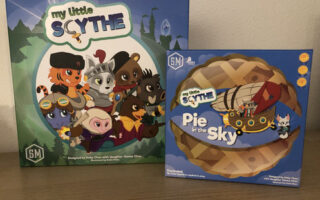
Summary
👥 a game for 1 to 4 players
⏳ Play time is around 45 minutes
🏢 Publisher is Alderac Entertainment Group (AEG)

Introduction
In Let’s Go! To Japan, you are a tourist trying to plan and experience the most beautiful dream vacation in Tokyo and Kyoto.
The game is played over 13 rounds, during which you draw activity cards and strategically place them on the different days of your travel plan. At the end of the game, there is a final round where you go on your trip, and the cards are activated in the order you played them. The player who has accumulated the most points by the end of the trip wins the game!

Setting up the game
Each player receives a player board, a set of 6 different condition tokens in their player color, a set of 5 different experience tokens, a mood token in their player color, a stress token, and a happiness token.
Place the 5 experience tokens on the leftmost ‘0’ field on the experience track on your player board.
Place your mood token on the hexagonal field in the middle of the mood track at the top of your player board. Place the red stress token on the leftmost field of your stress track, directly below the mood track, and place the green happiness token on the leftmost field of your happiness track.
One of the players places their 6 condition tokens randomly on the circles of the days (Monday to Saturday) at the bottom of their player board. The other players place their condition tokens in the same order as the tokens of the first player.
Place the train, joker, research, walk, and ‘+12’ tokens in separate stacks as a general supply within reach of all players.
Shuffle the Tokyo activity cards and place them face down in a Tokyo draw pile within reach of all players. Do the same with the Kyoto activity cards and place the Kyoto draw pile face down next to the Tokyo draw pile. Leave space for a face-up discard pile.
Place the round board in the central play area. Place the round token on the first, leftmost circle so that the symbol underneath is not covered.
Each player receives 1 start train token.

Let’s get in on the table
Let’s Go to Japan is played over 13 rounds, during which all players play simultaneously.
The round board indicates which cards should be drawn: T = Tokyo, K = Kyoto, and an image with cards and an upward arrow represents the cards in the top right of your player board. Below the symbols, it indicates how many cards you need to pass to the player on your left, up to round 7. From round 8, you pass the cards to the player on your right.
A round consists of:
- Draw cards
- Play cards and possibly receive a day bonus
- End of a round
Step 1: Draw cards Draw the cards indicated on the circle of the round board.
In the 13th and final round, draw the last card on your player board and one card of your choice from one of the two draw piles.
Step 2: Play cards You now play 1 or 2 activity cards, depending on the text on the round board.
A bit of extra information about the cards and where you might want to play them: At the top of the card, it indicates which of the 5 experience tokens on the experience track on your player board will move forward and/or which direction the mood token on your mood track will move.
Important! You only move the tokens in the final round before you go on your trip. The bottom part of each card indicates the possible bonus points you can earn in the final round if the card is in the ‘highlight of the day’ position (bottom card in a column) and meets the conditions.
When playing cards and aiming to score as many points as possible, keep the following in mind: The cards in each column must overlap so that the top part of each card is visible, and the card at the bottom of the column is the only card fully visible. That card is your current ‘highlight of the day’ card for that day. If this remains the case in the final round, you can earn the bonus points at the bottom of the card. Pay close attention here, as you can score extra or miss out.
When adding a card to a day that already has a card, choose whether to slide the card under this card or place it at the bottom of the column. The played card is now in the ‘highlight of the day’ position. When adding a card to a day that already has 2 cards, you have the extra option to play the card between the 2 previously played cards. The top part of the card must always remain visible.
Play cards on a day where the condition token on your player board matches the most symbols in the top section of the card. This will earn you day bonuses. Play Tokyo cards adjacent to other Tokyo cards and Kyoto cards adjacent to other Kyoto cards, so you need fewer train tokens to travel between Tokyo and Kyoto.
If you play a third activity card in the column of a day, you have fully planned that day and check if you receive day bonuses. You do this by adding up the symbols that match the condition token placed for that day during setup, in the top section of the 3 cards. Depending on the number of matching symbols, you choose one of the available bonuses as indicated in the top left of the player board.

Walks
Do you come across a covered walk card or extra walk card in your travel plan during the scoring? Turn the card over and choose: play and activate the card at the current position or leave it covered.
If you leave the card covered, you get 1 point, a boost on the mood track, and the walk symbol counts towards future ‘highlight of the day’ bonuses. If you play the card open, you take a walk token as a memory, and it counts as an extra walk symbol for later bonuses.
If a walk or extra walk card is at the bottom of a column in the ‘highlight of the day’ position and you leave it covered, you immediately get 2 extra points, without further conditions!
Trains
You don’t have to place trains immediately, but you must place them before you activate the cards in your travel plan. Each time you travel from Tokyo to Kyoto or vice versa, you must place one of the following train tokens between the activity cards in your travel plan:
- Start train token: You receive this at the beginning but don’t have to play it first; it just doesn’t earn any points.
- Luxury train: You received this as a day bonus. You get 2 points and move 1 space forward on your mood track.
- Regular train: You receive this if you have no start or luxury train left; for this, you get 2 penalty points.
Each time you travel between the two cities, you must use a train token.

The game ends
The game ends after 13 rounds, and then we will add up the points.
You receive points for the position of each of your 5 experience tokens on your track. Additionally, you receive points for the position of your stress and happiness tokens, possibly points from trains, and remaining research tokens.

Conclusie & eindscore
Difficulty: 2.25/ 5
Re-playability: 8
Our score: 7 out of 10 dice
In Let’s go to Japan, you get to plan a trip through this beautiful country. At least, we think it’s a beautiful country, unfortunately, we’ve never been there :-(. In any case, it’s a lot of fun to plan your trip.
The artwork on the cards is very well done and makes the game even more enjoyable. We find the actions you need to perform very fun; you can occasionally mess with other players by giving away certain cards, but initially, you’ll want to choose which cards to play for yourself. Placing the cards as best as possible with the corresponding experience tokens can sometimes be a challenge, but that makes it all the more fun. There are many actions to pay attention to during the game, such as happiness or fatigue, obtaining train tickets, jokers, etc., all while placing your cards as best as possible. If you can’t place a card at some point, you can choose to go for a walk, which quickly gives you the opportunity to keep playing.
We find Let’s go to Japan a fun game to play; it’s easy to explain to other players and doesn’t take very long in terms of time. The only point we have is the replayability in the long term; we wonder if planning will still be very fun as not much else happens in the game. You really have a lot of cards, but it would have been nice if the round board with the cards had something different if you turned it over, just to give the game a little twist.
We also recommend this game for solo players, with fun and short rules, and just as surprising as with multiple players.
Thanks to the publisher for this review copy and the opportunity to write about it






